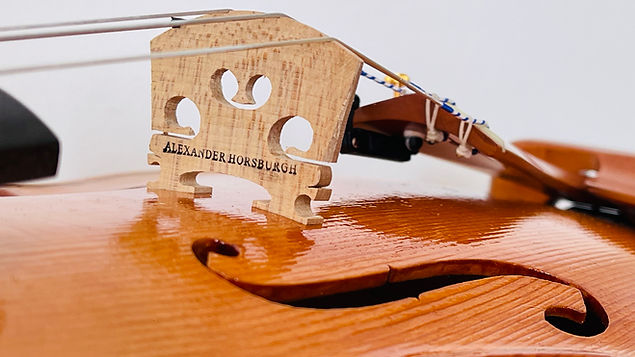
Drawing a violin
A method for drawing the outline and mould of a violin
This is a description of a system for drawing the outline of a violin (front and back plates) based on systems described by Simone Zopf in the The Strad in March 2023 and by Kevin Kelly in The Strad in January 2019.
Both systems are predicated on the idea that those who originally came up with the shape of the violin would have had only basic tools — namely straightedges or rules and dividers or compasses. They are unlikely to have had a knowledge of complex algebra. This system uses paper, pencils, an eraser, rulers and a compass.
I have used two units of measurement, the millimetre and the oncia (pl. oncie). Millimetres require no explanation but oncie do. Zopf argues that a majority of violins by the great Cremonese makers of the 17th and 18th Centuries — by the Amatis, Stradivari and the Guarneris — conform in their dimensions to measurements taken in whole Roman oncie. While different cities had different standards of oncie, in Cremona in the golden age of violin making, a Roman oncia has been calculated to have equalled 18.66mm. 19 Roman oncie equal 354.54mm, almost exactly the ideal length of a violin. Upper bouts are 9 oncie wide (168mm), Lower bouts are 11 oncie wide (205mm) and C bouts are 7 oncie wide (112mm). Measured down the centre line, the bridge stands 1 oncia below the centre point and the f-holes extend 2 oncie up and 2 oncie down from where the bridge stands.
My system treats the oncia as a unit of variable length. In designing a five-string violin, I wanted it to be about 3% larger than standard, so I multiplied 18.66mm by 1.03 to produce a “new oncia” of 19.22mm. If you wanted to make a 3/4 violin with a back length of 335mm, you would divide 335 by 19 to produce an oncia of 17.63mm. You then simply follow the system outlined below.
For ease, and for fun, I made a couple of rulers from scrap wood marked in oncie, one at 18.66 and the other at 19.22. There is no need to do this, but it makes setting the compass a little quicker.
Following the example of Zopf, in the description below, I use the symbol - ” - as an abbreviation for oncia. That should not be confused with an imperial inch, unless you are making a viola with a back length of 483mm, (19 inches) — probably not advisable!
Given that The Strad does not offer a limitless word count for contributors, both articles probably miss out some steps, which I have tried to reconstruct. For instance, I think that Zopf’s system uses too few circles; in particular, I think there needs to be an arc with a wider radius than she offers to take the outline from the widest point of the upper (or lower) bouts to where the concave arc for the corners begins. Despite Kelly’s system being called the “Four Circles System”, he actually uses many more circles, including a larger one which smoothes this curve.
Zopf’s system draws the outline of the plate while Kelly’s draws the outline of the mould. By calculating the thickness of the ribs plus the overhang and adjusting the compasses accordingly, you can draw the outline of the mould at the same time as drawing the outline of the plate. For the basic outline, the plates are drawn first, followed by the mould, in stages. However, when the corners are being drawn, the mould (in effect, the corner blocks) is drawn first and the drawing is completed by adding in the outline of the corners of the plates.
It is probably best if this is undertaken as a two stage process. To check that the instrument will have the basic shape and dimensions you wish, you need only do stages, 1-10 (with the possible exception of 4), 14, 18, 20 and 22. From that, you’ll be able to check the length, body stop and the widths of the upper, C, and lower bouts. After you are happy with these measurements, start again (unless it has turned out perfectly first time) and follow all the stages.
Some terms:
Centre line: the vertical line from the top to the bottom of the instrument
Centre point: the point from which all the concentric layout circles are drawn, which is not necessarily halfway between the top and bottom of the instrument, but is halfway between the bridge and the C bout width line.
Upper bout width line: a horizontal line with crosses the edge of the upper bouts at their widest point
C bout width line: a horizontal line with crosses the edge of the C bouts at their narrowest point
Lower bout width line: a horizontal line with crosses the edge of the lower bouts at their widest point
Vertex: a point where two or more curves, lines, or edges meet
Treble side: right hand side of the instrument
Bass side: left hand side of the instrument (I’m assuming you will be drawing the belly, and will add f-holes later.)
Corner tip: the sharp end of the corner block. The actual rib corners will be beyond this and the plate corners a bit further beyond again.
Upper plate corner tip: on the lower corners, this is the corner of the corner (so to speak) which is nearest the C bouts. The lower corner tip is the one nearer the lower bouts.
Lower plate corner tip: the opposite of above.

![[Original size] Alexander Horsburgh.png](https://static.wixstatic.com/media/02ca75_913004bf855d4c82af1d66f85d4315d6~mv2.png/v1/fill/w_261,h_261,al_c,q_85,usm_0.66_1.00_0.01,enc_avif,quality_auto/%5BOriginal%20size%5D%20Alexander%20Horsburgh.png)